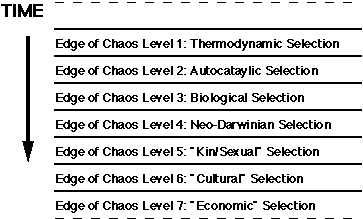
If there are levels of complexity in the involution of our universe, then what are the selections laws that govern the involution? Ilya Prigogine has a more general notion of selection than neo-Darwinian natural selection. He views the second law of thermodynamics as a thermodynamic selection law ([15] pp 285). In the realm of physics, Lee Smolin in his recent book [18] has opened the debate to whether there is a selection process at the universe level.
Nevertheless, the most evident and understood process of selection is ``natural selection'' based on the neo-Darwinian biological theory. However, the Darwinian theory has centered on the study of eukaryotic multi-cellular evolution. On the other hand, the evolution of prokaryotes and the epigenetic inter-cellular mechanisms in the development of animals has been mostly shrouded in mystery. The debate is beginning in the biological community how much the conventional neo-Darwinian evolutionary principles can explain the biological phenomena at multi-cellular level[6]. Only recently has there been any discussion in the biological community about possible incompleteness of the Darwinian principles (see Buss [2], Smith and Szathmary [17]). Besides the evolution of bacteria and the transition to multi-cellular organisms, there is also the cultural evolution of the human race, which may involve a more complex selection process, such as the Baldwin effect [1].
If one can accept a more general notion of selection in involution,
then the next question is what is the structure of the selection processes.
Given that each level of complexity builds upon the previous levels, it
seem plausible that the simple selection laws at the lowest level put constraints
on the higher levels. As a higher-level macrosystem involutes, higher-level
selection laws begin to operate. A plausible sequence of selection processes
would be as in Figure 10.

The involution of carbon-based molecules(proteins, lipids, nucleic acids, plastics), ``single-cells'' (viriods, viruses, prokaryotes), ``organisms'' (multi-celled eukaryotes), ``families'' (e.g., ant colonies and human families), and human ``societies'' (tribes, corporations, nations) surely have similar selection processes. The key question is what are the differences in selection processes at each level of complexity.
The non-equilibrium thermodynamic process uses time and space as it main separation criteria as a selection difference. It exhibits the three regimes of chaos, order, and edge-of-chaos. All it requires is that the macrosystem be a dissipative structure. If all of the macrosystems are thermodynamic entities, then even the most complex proposed macrosystem, MetaMan, should exhibit properties of this process. Indeed, it has been noted that mankind has dissipated the earth's energy to a larger extent than simpler organisms. Moreover, modern civilized man has shown even more predilection for consuming energy than less technological humans. Given that MetaMan, Hypersea, Gaia, and Earth are first thermodynamic systems as they involute, then it should follow that the higher-level microsystems, such as organisms, with initially behave as simple dissipative elements in a thermodynamic process. Indeed, when studying the history of both physical systems and living systems the recurring themes of chaos, order, and the edge-of-chaos appear in broad patterns.
Just as the thermodynamic macrosystems, such as galaxies, first exhibit thermodynamic selection, the more complex macrosystems will evolve from first from a simple thermodynamic system to having a more complex selection process of ``chemical'' selection. Hence, these more complex macrosystems will exhibit secondly the non-equilibrium chemical thermodynamics characterized by the notion of autocatalytic sets. It stands to reason that the more complex macrosystems will continue to involute to exhibiting in succession: simple biological selection (one level reproduction), Darwinian selection (two level reproduction), and possibly cultural selection.
If this notion of succession of selection processes is correct, then this gives us a powerful tool in predicting and understanding the future. As involution of Metaman proceeds via the development of the Internet, the structuring of corporations, and the advance of technology, it should exhibit the stages of selection processes. Hence, the detection and analysis of analogous lower-level processes will help predict the overall structural processes and transformation of the Earth, life, and mankind in the future.
Despite the inherent difficulties in making conceptual analogies between seemly disparate phenomena [16] such as atoms, molecules, cells, and organisms, there is much to be gained by attempting to precisely understand the underlying regularities. The primary reasons for this are to better understand both the general laws at each level of complexity and the historical quirks that happened in our particular path of involution.